Last Train Home Review
A cold caboose
It's been a pretty good year for train games. From the assortment of simulation-type experiences, to the management games like Railway Empire 2, and puzzle games such as Railgrade and Station to Station. It was a decent year for RTS games also, with Company of Heroes 3 bringing the action, and Shadow Gambit: The Cursed Crew covering the stealth. We've also had the usual assortment of survival and adventure experiences, such as The Pale Beyond. But what do all these games have in common? Developers Ashborne Games and publisher THQ Nordic hope to answer that question with Last Train Home, an adventure, survival, and RTS game mix.
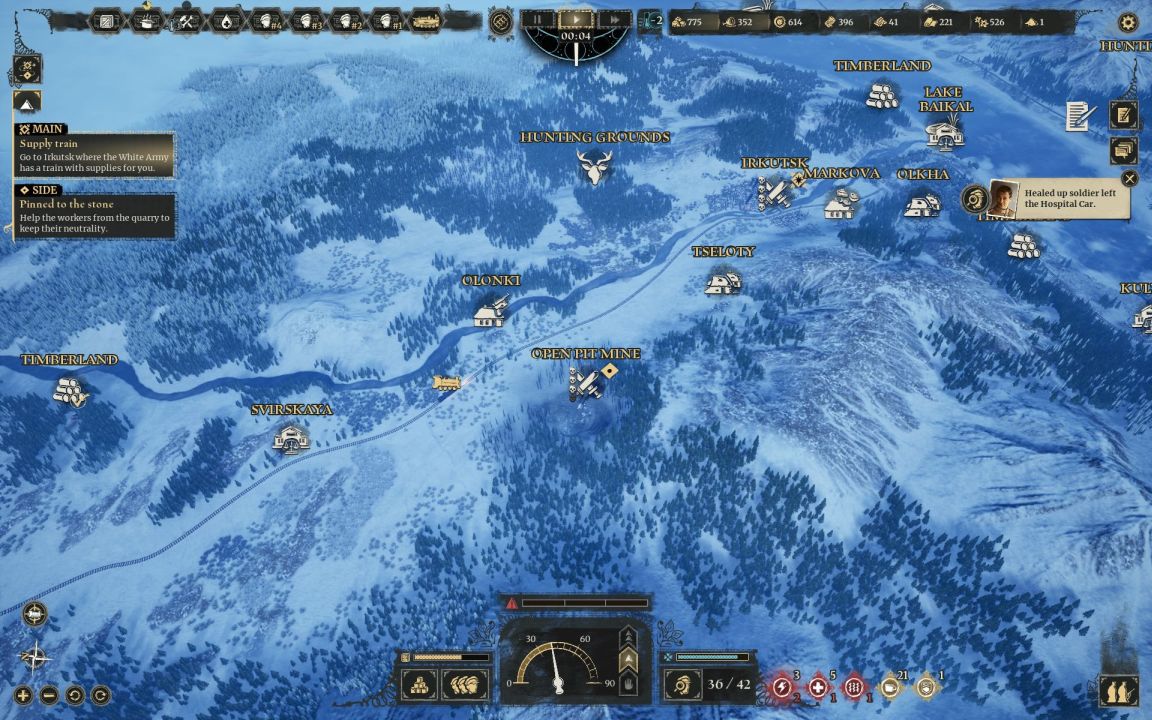
The journey in Last Train Home kicks off with a very engaging opening. It's the end of World War I, and a group of Czechoslovak Legion soldiers find themselves in the middle of Russian territory. While the war may be over, there is turmoil and uncertainty back home, as the government is trying to form their new independent republic. But more pressingly, the soldiers are caught in the middle of a new conflict, the Russian civil war between the Reds and Whites. Your orders are to remain neutral and try to make it across the country in an armored train, through the Siberian winter, to a city on the far east of the country where a ship purportedly awaits to take the soldiers home. You may be just trying to get home, but to both the Red and White armies, you are a foreign Legion on their home soil.
The strong narrative thrives thanks to the incredibly unique situation – some of it based on historical tales – for this group of soldiers and their train. It's difficult to think of another game, historical or otherwise, that puts the players in such a peculiar setting. While told to remain neutral, you will be fighting against the Bolshevik Red Army for the most part, as the soldiers witness their atrocities against civilians and the unprovoked attacks. While the orders from the Czechoslovak government keep arriving, they often lack clarity and it's up to you to make the verdicts. You'll have to decide how to deal with both groups of revolutionaries, how much to help local civilians, and so on. The choices are often fairly predictable by adventure game standards, but are nonetheless engaging thanks to the setting.
The game features tons of text, both through the main narrative and optional missions, which you scroll through as various events and conversations occur. While the amount of text is impressive, not all of it is well-written; there are occasional strange sentences and odd grammar, and too many modern mannerisms that break the historical immersion somewhat. Likely, some of the intricacies were lost in translation from the Czech Republic-based developers. On the other hand, the game has some nice authenticity options, letting you choose between Czech, English, and more audio dialogue languages.
Last Train Home is split into two gameplay experiences, tightly interwoven together. First is the survival adventure game element, where you must worry about the wellbeing of your crew aboard the train as it rolls across the overhead campaign map. You can stop anytime and anywhere, as well at stations along the route, in order to create squads of soldiers and send them out to points of interest indicated on the map. These usually involve combat encounters, or gathering raw materials where you simply have to wait for a certain time. The game thankfully indicates what you can expect to find – so you can send the right squad for the job. As you make your way across the map – which is split into standalone chapters – you will also encounter story events and random events, where you may need to make choices on how to proceed, or even ignore optional quests altogether if you feel unprepared and just roll-on.
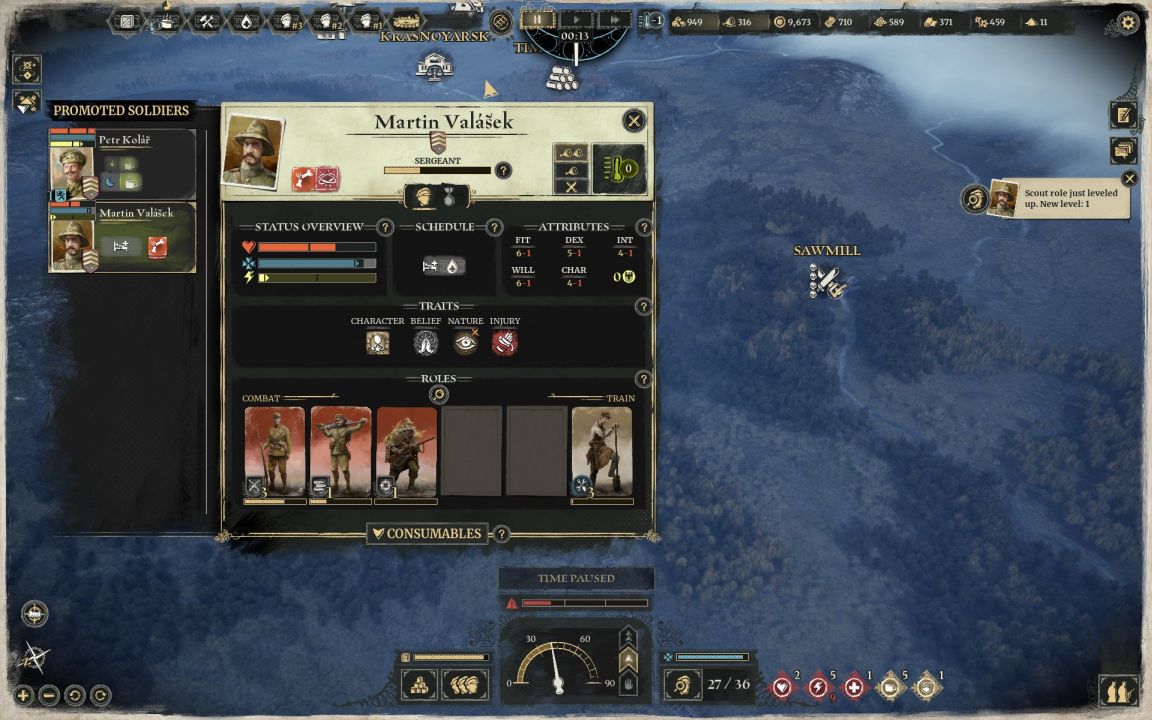
During the journey, you can control if the train is stopped, moving at regular speed, or max speed; players also control the passage of time in a similar manner, and both are crucial in dealing with the issues that crop up. You may want to stop while performing repairs / upgrades on the train, or wait for a squad to return from a point of interest. But the game does a good job of ensuring a sense of danger and urgency - you can't be stopped for too long because an enemy alert meter fills up, as enemy planes gradually discover your position and may begin aerial strafes. This mechanic is balanced well enough that it doesn't become annoying, but remains a constant threat. Another key aspect of time is the day and night cycle, which also affects gameplay– you need staff to man various posts on the train at both times of day, the weather gets colder at night, so there are more decisions to make on when and where to send out squads.
Squad and individual soldier management are at the heart of the experience, and will remind players of games like XCOM given the extensive micromanagement that is needed. Each soldier has their own name, portrait, stats, and work roles. The game tries extremely hard to make them all individuals, and you can't help but become familiar with your crew over the journey, as the Legion only grows to be about 40 members strong at most. By performing well on missions and working their jobs aboard the train, they gain experience, which increases their efficiency and also lets you assign skill points into typical ratings such as Strength and Dexterity, as well as picking new roles for them. Each soldier can have three combat roles, such as Grenadier, Sniper, or Medic, and three train roles, like Worker, Cook, or Engineer. This provides a lot of flexibility and utility for each soldier.
You'll need that flexibility when considering that everyone also has a health, stamina, and morale meter that must be in good order to avoid sickness, depression, and being tired – all of which affect performance. Though it may depend on player choices and other random elements, keeping these key meters afloat is not too bad. Most issues can be fixed by simply letting the soldier rest for extended times and not send them into exploration or combat. This means a lot of squad rotation and careful planning. One element that could certainly be cut is the personality trait system – each soldier has a wide variety of possible personas, such as being impatient, aggressive, friendly, and so on. But other than a few extra lines of dialogue, most have no gameplay impact. You only really need to keep an eye on the 3-4 traits that aid with exploration and provide a chance of bonus materials; the rest are just noise. You'll have to scan through these personality icons often as you create and disband squads all the time, quickly putting groups together specifically built for exploration or combat, while letting others rest or heal.
Managing the train itself is a bit less complicated. You have to oversee the damage levels of the train, each car's status and upgrades, and the main steam locomotive. At certain points of the story, you get a chance to purchase a new leading locomotive, with the decision being if you want a slower, more coal consuming train that can haul more cars, or a faster train that can't carry as much behind it, or stick with the in-between option that you get at the start. A bit more frequently, you get an opportunity to purchase more train cars, which can be soldier living quarters, a kitchen, an engineering station, a storage car, a medic car, or an artillery piece. Your funds will be extremely limited – along with your towing capacity – so the composition of the train cars is a big campaign choice.The train cars themselves can also be upgraded (the train must be stopped), with things like expanded storage capacity, increased defences, and also insulation or a heating source – a key element for the late/mid part of the campaign when temperatures drop and the cold becomes as much of an enemy as the hostile armies. While cold, your soldiers fail to recover their stamina and health, which can cause problems to snowball (pun intended).
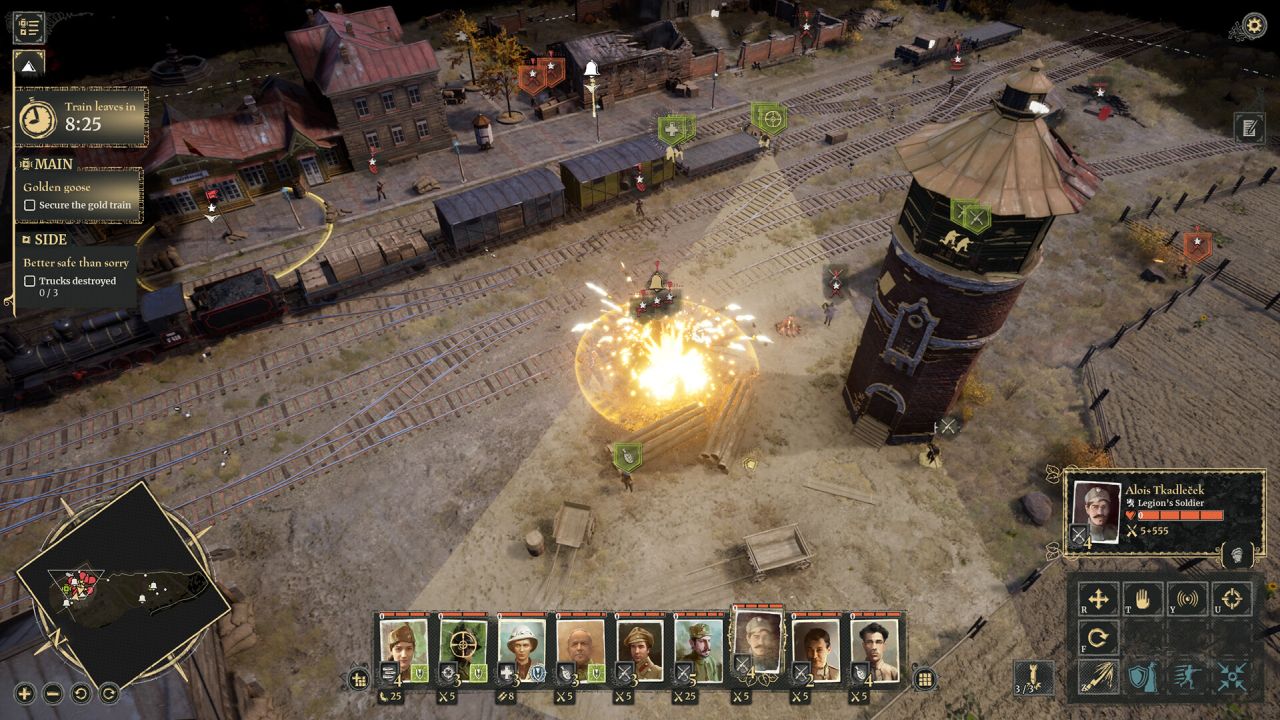
Some train cars have job positions – a cook, a doctor, an engineer – that can be filled by soldiers who have that role unlocked. There are two shifts (day and night), and generally just picking soldiers for these roles early and keeping them long term (barring injuries, which can happen on the job) is the best course of action. There's already enough to do managing the combat and exploration squads, and you will still have to annoyingly micromanage the soldiers that are recovering in the medic car, as they don't automatically fill available beds. The medic and engineering jobs are a little more hands-on, as you can also assign development and crafting tasks, such as upgrading your combat capabilities and creating new ammo and consumables.
Consumables are part of the goods that you will have to manage aboard. These one-time use items can have great effects – such as health kits, vodka to boost morale, coffee to stave off hunger and boost stamina. But they are rare to come by, and must be used carefully. There are plenty of opportunities to stop by local vendors who trade in some of these goods, so it depends on how you want to play and manage the survival of your soldiers. If you try to visit as many points of interest as possible, and generally avoid spending money, you should have plenty of raw materials to keep your soldiers fed and warm, and to trade excess away or burn as fuel in an emergency – but at the potential expense of your combat capabilities, like having an artillery train car that can provide a bombardment during missions, having higher tier weapons, and so on.
The combat missions are the other major part of the gameplay experience in Last Train Home. For these excursions, you first create a squad. Once again, decision points arise as you have to ensure your squad has a good balance of soldier types, as they have unique abilities. Snipers can provide invaluable map reveals, grenadiers can throw smoke and explosives, machine gunners can deploy their weapons for a powerful area effect, and so on. Players get a further choice of which active and passive abilities each soldier has equipped, which range from faster firing speed to increased benefits of taking cover. Last but not least, you also equip primary weapons, which come in different quality tiers with better stats – although that doesn't really become a factor until later in the campaign.
Once you deploy with a squad into a combat mission, the gameplay switches to an RTS-like experience. The objectives are typical but varied, from clearing outposts to stealing resources from factories, and often have optional side goals. Controlling each member of your squad (of up to 10) individually, you will have to make your way through a number of different locations, from forests and villages to more urban levels and enemy trenches. The isometric camera and variable zoom levels, along with the ability to pause time and issue specific orders or use abilities like throwing grenades; are all par for the course, and may remind players of games like Men of War and Company of Heroes. Using cover is extremely important – soldiers running around in the open are bound to be punished for it, and flanking the enemy dispatches them much quicker than both sides sitting in cover and shooting. The maps are a little finicky in what is considered to be viable cover, but at least the UI very clearly indicates those opportunities when moving around.
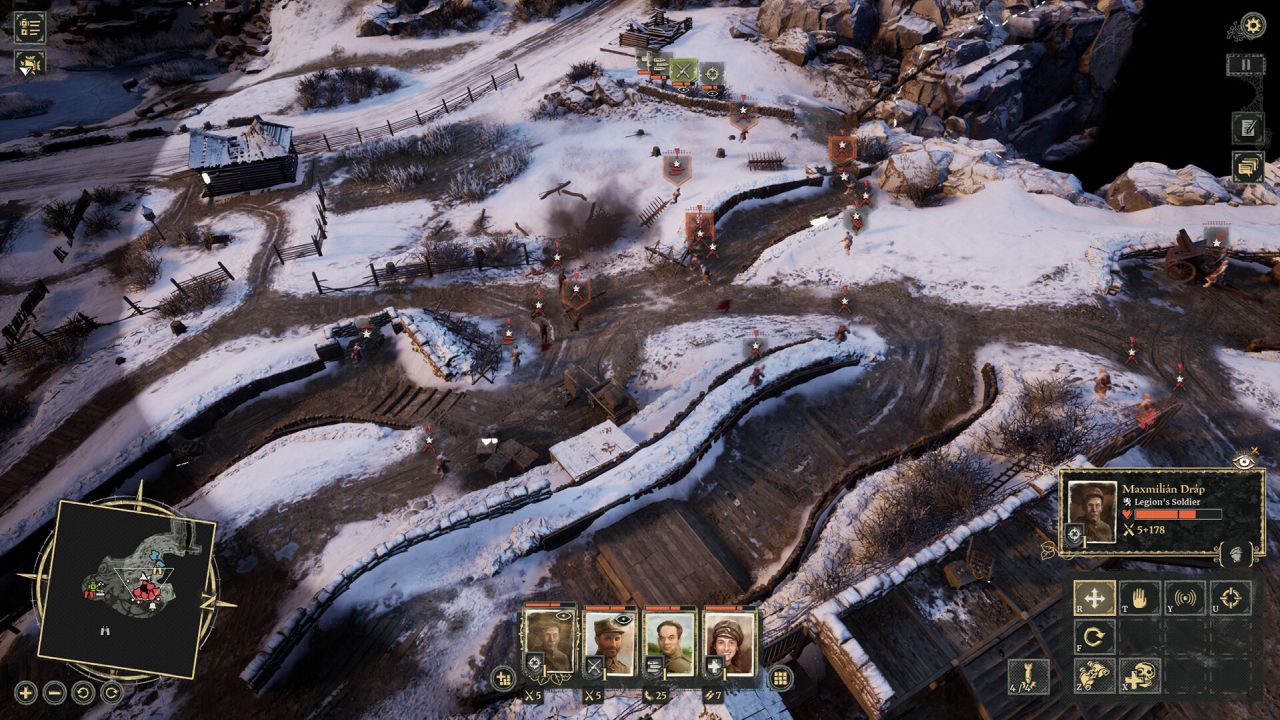
But this isn't a game for fans of the more action-oriented RTS like COH, and actually a little more in line with games like Shadow Tactics. It won't be long until you are outmanned and outgunned, and in the second half of the campaign those negative odds continue to rise exponentially. So the missions are actually heavily skewed towards stealth, as fighting head-on (and even with big flanks through terrain passages) is extremely costly. When you start facing off against enemy emplacements and vehicles, it becomes an overwhelming task. The power of these weapons will simply tear your squad to shreds, and they feel extremely menacing – and to be fair, when you finally get to use them on a few maps, extremely satisfying too. Still, towards the end of the game, the tough missions become a grind as you barrel towards the destination 20+ hours in the making. It also doesn't help that the pre-deployment information is often highly incorrect about the recommended squad size and actual difficulty.
When critically wounded, your soldiers will first be knocked down, and can be revived/healed by another, but on the second knock down in the same mission they are permanently killed. There's nothing worse than losing a high ranking member, not to mention you don't know when more soldiers will join your train journey. This death state condition is default in the game's normal difficulty settings, and it - among others - can be toggled to make things tougher or easier, in both combat scenarios and the general survival gameplay and train management. Heavily wounded soldiers will move slower, and will need longer treatment when you get back from the mission.
So you'll probably crawl through most of the maps, telling your units to engage in silent mode where they don't open fire unless provoked and use hushed voice lines. Using snipers, you can reveal areas up ahead and avoid walking into ambushes. Walking up behind enemies, who have a visible field of view, knocks them out silently. There are no silent ranged weapons, but the alert from gunfire also doesn't spread very far, so you can observe and eliminate enemies one patrol at a time. Still, stealth can be annoying due to strange and inconsistent walking patterns by the AI enemies, who can turn at half-animations, speed up and slow down randomly, and generally behave a bit erratically. This leads to a lot of mistakes that are not your fault, and mission-ending encounters. We've also had a bug where a well-placed grenade refused to explode in a group of enemies. The game shockingly does not autosave at all during missions, only during the train journeys. So you are sort of forced to save-scum a little bit, in true XCOM fashion, to ensure one bad AI move, you could not predict, does not unravel the whole mission.
Another reason to use a stealth approach is ammo. It's a resource that's managed by-the-bullet for four separate weapon types, and every time your soldiers fire on the enemy, it's an expenditure. There will be cases where things get really awkward as your squad actually begins to run out of ammo, because you've spent it all shooting and missing at enemies sitting in heavy cover. Like COH, not every shot is going to hit, as there is an element of randomness involved. It's frustrating, but it makes sense and fits the hardcore level of micromanagement that the game strives for.
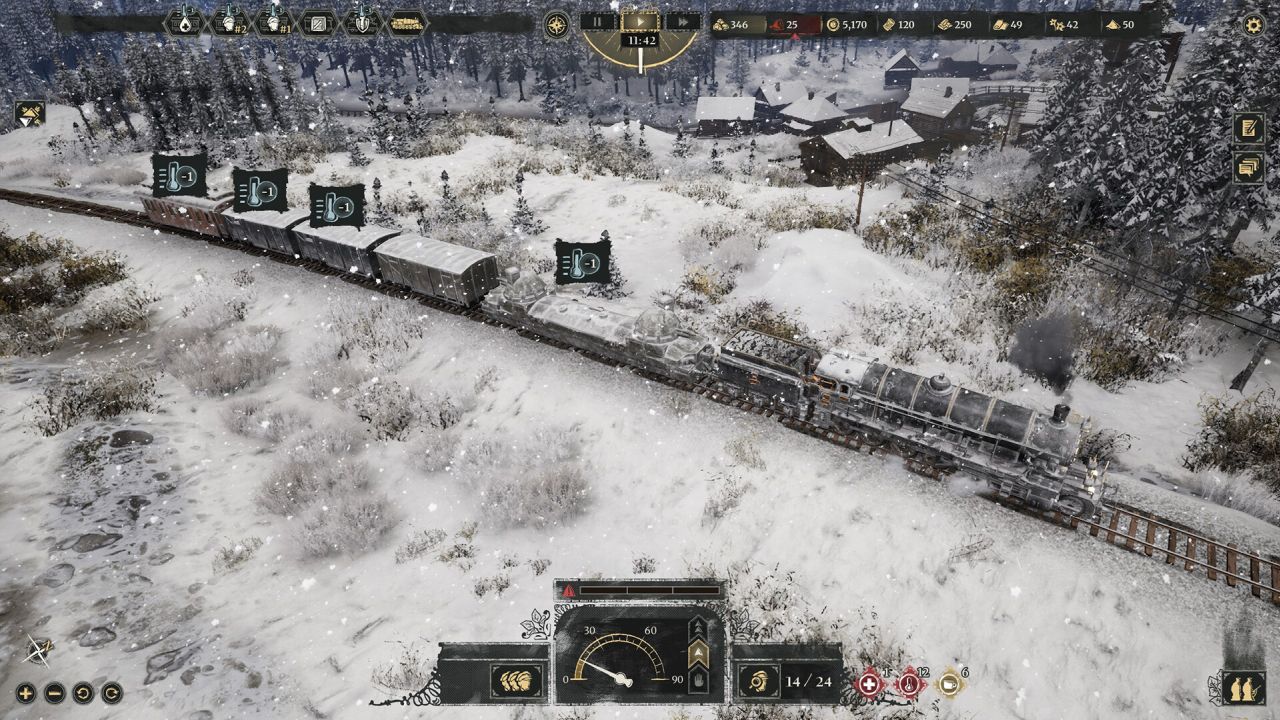
What's less forgivable is the game's UI. During the first couple of hours with the game, looking at the soldier management screens can be quite overwhelming, and there is an absolute ton of information being communicated. To the game's credit, once you get used to it, these info screens are actually quite good at presenting all you could possibly need to know, but it certainly takes time and isn't always intuitive. Another example is assigning jobs on the train, as you can't actually sort by proficiency of that job skill, and have to manually scroll through a small window. Elsewhere, soldiers with too many personality traits get collapsed into two rows of tiny icons that are barely visible at a quick glance. The UI could have certainly used a bit more polish and quality of life improvements.
Presentation on the whole is pretty good, though. The campaign overview map is atmospheric as you roll along the tracks, and you can zoom in to your train at any time to view the individual cars and soldiers working or resting within. The RTS missions feature maps with a nice visual variety and day/night variables. You can also zoom in and see the soldiers up close, though the animations are not exactly top notch. Between missions, there is a lot of quality audio narration and stylized video clips recapping the story, including live-action ones. The game performs well and we did not experience any crashes or framerate hiccups. The soundtrack is also fitting, with a few different themes depending on the intensity of the action. Combat sound design is often excellent, with gunfire and explosion effects feeling very punchy.
Last Train Home tries to combine two quite different gameplay experiences, and for the most part succeeds. The RTS gameplay during the missions is tough and skews towards stealth, and while some AI polish and better balancing is needed, many mistakes are a result of your own actions. The equipment and quality of soldiers that you bring into the missions is supported by the engrossing survival gameplay of traversing post-WWI Russia and the many dangers along the route. Managing resources and train cars is challenging but fair, and many decisions will need to be made on how you get these soldiers home. These two core components are further elevated by an engaging narrative setting with historical foundations. Although it could have used more polish and quality of life improvements, particularly with enemy AI and the user interface, Last Train Home offers a dangerous but enticing journey with an interesting blend of gameplay styles that's likely to keep your attention for hours at a time.
 Comments
Comments




















